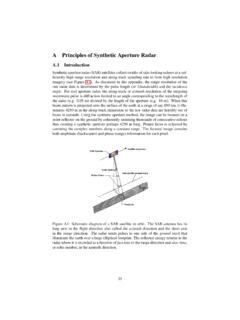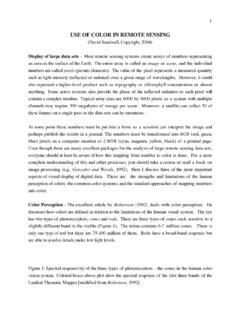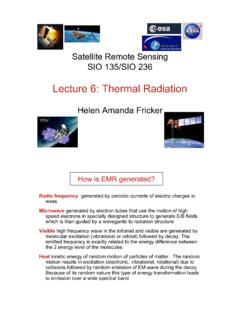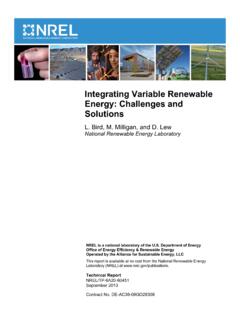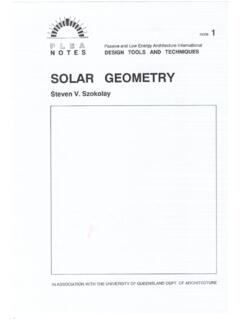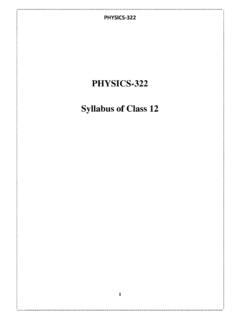Transcription of Lecture 7: Propagation, Dispersion and Scattering
1 Satellite Remote SensingSIO 135/SIO 236 Lecture 7: propagation , Dispersion and ScatteringHelen Amanda FrickerEnergy-matterinteractions atmosphere study region detector Interactions under consideration Interaction of EMR with the atmosphere Interaction of EMR with matterscatteringabsorptionInteraction of EMR with the atmosphere EMR is attenuated by its passage through the atmospherevia Scattering and absorption Scattering -- differs from reflection in that the directionassociated with Scattering is unpredictable, whereas thedirection of reflection is predictable. Wavelength dependent Decreases with increase in radiation wavelength Three types: Rayleigh, Mie & non selective scatteringJensen 2005 Jensen 2005 Jensen 2005 Major subdivisions of the atmosphere and the types of moleculesand aerosols found in each Layers and ConstituentsJensen2005 JensenJensen20052005 Atmospheric ScatteringType of Scattering is function of.
2 1)the wavelength of theincident radiant energy, and2)the size of the gas molecule,dust particle, and/or watervapor droplet Scattering Rayleigh Scattering is molecular Scattering and occurs when thediameter of the molecules and particles are many times smaller than thewavelength of the incident EMR Primarily caused by air particles O2 and N2 molecules All Scattering is accomplished through absorption and re-emission ofradiation by atoms or molecules in the manner described in thediscussion on radiation from atomic structures. It is impossible to predictthe direction in which a specific atom or molecule will emit a photon,hence Scattering . The energy required to excite an atom is associated with short-wavelength, high frequency radiation.
3 The amount of Scattering isinversely related to the fourth power of the radiation's wavelength (!-4).Jensen2005 JensenJensen20052005 Rayleigh scatteringThe intensity of Rayleigh scatteringvaries inversely with the fourthpower of the wavelength (!-4).So blue light ( m) is scattered16 times more than near-infraredlight ( m).Rayleigh Scattering Responsible for the blue sky. The shortwavelengths (violet/blue) are more efficientlyscattered than the longer wavelengths(orange/red). Blue sky is a result of thepreferential Scattering of the shortwavelength light. Responsible for red sunsets. Since theatmosphere is a thin shell of gravitationallybound gas surrounding the solid Earth,sunlight must pass through a longer slantpath of air at sunset/ sunrise than at wavelengths (violet/blue) are scatteredeven more during their longer path throughthe air, what we see when we look towardthe Sun is the residue - the longwavelengths of sunlight that are hardlyscattered (orange/red).
4 Rayleigh scatteringThe approximate amount of The approximate amount of Rayleigh Rayleigh Scattering in the atmosphere inscattering in the atmosphere inoptical wavelengths ( optical wavelengths ( m) may be computed using them) may be computed using theRayleigh Rayleigh Scattering cross-section ( Scattering cross-section (""mm)) algorithm: algorithm:where where n = refractive indexn = refractive index, , N = number of air molecules per unitN = number of air molecules per unitvolumevolume, and , and !! = wavelength = Scattering Mie Scattering takes place when there are essentially sphericalparticles present in the atmosphere with diameters approximately equalto the wavelength of radiation. For visible light, water vapor, dust, and other particles ranging from afew tenths of a micrometer to several micrometers in diameter are themain Scattering agents.
5 The amount of scatter is greater than Rayleighscatter and the wavelengths scattered are longer. Pollution also contributes to beautiful sunsets and sunrises. Thegreater the amount of smoke and dust particles in the atmosphericcolumn, the more violet and blue light will be scattered away and onlythe longer orange and red wavelength light will reach our Scattering Non-selective Scattering is produced when there are particles in thelow atmosphere several times the diameter of the radiation beingtransmitted. This type of Scattering is non-selective, all wavelengthsof light are scattered, not just blue, green,or red. Thus, water droplets, which makeup clouds and fog banks, scatter allwavelengths of visible light equally well,causing the cloud to appear white Scattering canseverely reduce theinformation contentof remotely senseddata to the point thatthe imagery loosescontrast and it is difficult to differentiateone object from molecules absorb different wavelengths of radiation: O2 and O3 absorb almost all wavelengths shorter than 300 nm.
6 Water (H2O) absorbs many wavelengths above 700 nm, but this dependson the amount of water vapor in the atmosphere (tropics vs poles) When you combine the absorption spectra of the gasses in theatmosphere, you are left with "windows" of low opacity, allowing thetransmission of only certain of EMR by atmosphereJensen 2005 Jensen 2005 Jensen 2005windowAbsorption of the Sun's incident electromagnetic energy in the Region from to 30 mm by various atmospheric gasesInteractions under consideration Interaction of EMR with the atmosphere Interaction of EMR with matterInteraction of EMR with matterRadiative properties of natural surfaces Radiation incident upon a surface must either be transmitted (!) through it,reflected (") from the surface, or be absorbed (#).
7 For solar radiation " is referred to as the surface albedo If we consider only part of the EM spectrum " is referred to as spectral reflectanceTransmissivity (!) + Reflectivity (") + Absorptivity (#) = 1 Radiative contribution in remote sensingFOV: field of viewDispersion When the dielectric properties (and therefore refractive index) of amedium vary with frequency, medium is said to be dispersive. Wave propagating through such media is called a dispersivewave. Wave or phase velocity given by v = # k where # is angular frequency and k is the wave number This is the speed at which the crests and roughs of the wavemove in the propagation direction Group velocity vg = d# dkPage 41-43 ReesRefraction When EMR passes from one medium toanother, it changes direction (bends) at theinterface because of the difference inspeed of the wave in the media.
8 Ratio of this speed difference is calledthe refractive index (n). Ratio of the refractive indices and thedirection of the two rays of light for the twomedia are expressed in Snell s law:where n1 and n2 are the refractive indices of the two media ' is the angle of incidence ( is the angle of dielectric constantFor most medium we shall need to consider, r = 1 (non magnetic materials)If the medium absorbs energy from the wave, the dielectric constant becomes complex(real + imaginery)$r = $ % i$ or $r = $ (1- tan &)loss tangentloss tangentSee page 36 of Rees, arrive at the following wave equation:See page 36 of Rees, arrive at the following wave equation:!! Ex = Eo exp (-#kz/c) exp (i [#t-#mz/c])Simple harmonic wave whose amplitude decreases exponentially with zFlux density F = F0 exp(-2 #kz/c)!)
9 ! Absorption length la = c/2#k Dielectric Properties of MaterialsRees discusses 4 categories of materials based on properties of theirdielectric constant:1)non-polar material $' and $" are constant with %2)polar material (water) $' and $" vary with % following the Debye3)conductive (salt water, copper) $" = & / [$'%]4)plasma (ionosphere) $=n2=1( Ne 2 $Ym%2 N - electron density m -electron mass e - electron chargeFor a plasma if n> 0 the waves are slowed as they travel through theionosphere. If n < 0, n is purely imaginary and all the energy is reflectedoff the ionosphere. Under typical ionospheric conditions, low-frequencyradio waves reflect while higher frequency microwaves can propagatethrough. Since the ionosphere is dispersive ( speed depends on %) adual frequency microwave instrument (a radar altimeter or GPS) canmeasure the total electron content of a column of ionosphere and can usethis to correct for the delay along the path of one or both of EMR with matterTransmission!
10 Incident radiation passes through matter without attenuation! Change of EMR is given by index of refraction n=n1/ n2 =sin)1/sin)2 Reflection (specular reflection)! Surface is smooth relative to wavelengths! Mirror-like surfaces are called specular reflectorsScattering (diffuse reflection)! Surface rough relative towavelengths! EMR velocity and wavelength arenot affected but EMR is redirectedAbsorption! Substance is opaque to theincident radiation! Portion of EMR is converted toheat energy (re-radiated)Interaction of EMR with mattersourcedetector Surface spectral imprint is embedded in the spectrum of thereflected wave Some incident energy is reflected and some is absorbedsource spectrumreflected spectrumReflection from rough surfaces All active remote sensing systems as well as passive systems whichmeasure reflected sunlight involve reflection of radiation from a roughsurface Surface roughness is important even for passive systems which measurethermal emissions since r = 1 - $ Recall we have defined terms such as radiance and irradianceRadiance (LRadiance (L!

